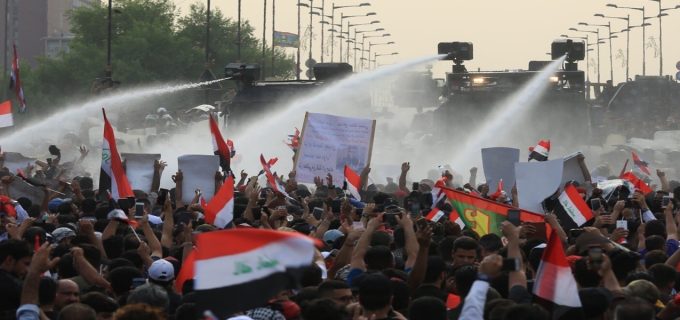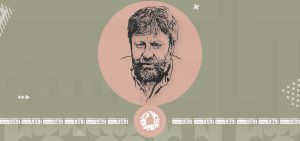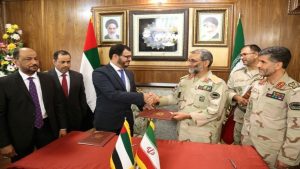At the beginning of October, several Iraqi cities witnessed a wave of large-scale protests, starting from Baghdad, Basra, Najaf, Karbala and Diwaniyah, and spread to a number of other Iraqi governorates, demanding the provision of water and electricity, addressing poverty and unemployment, and ending corruption and cronyism, in a country with the world’s fourth largest oil reserves.
The protests come after a series of sporadic demonstrations by unemployed university graduates, and a year after the formation of the new government headed by Adil Abdul Mahdi, which was considered by the protesters as an epitome of failure in addressing the deteriorating living conditions, in light of the political disputes experienced by Iraq due to a chronic state of political quotas.
For more than a week, Iraq has undergone the pressure of the escalation of the protesters, on the one hand, and the oppressive practices of the security services against the demonstrators, on the other hand, leading to the death of more than 100 and wounding thousands. In a later stage, the Iraqi street calmed down; which raises a number of questions related to the nature of the Iraqi political scene, the developments of this wave of protests, the motives of the various parties, and the reasons behind the retreat of demonstrators, as well as the possibility of launching another wave of protests in the coming days.
Context of events
This wave of protests began in Baghdad in early October, heading towards Tahrir Square. The next day demonstrations spread in the east, west and south to include Karbala, Diyala, Dhi Qar, Maysan, Najaf, Wasit and Basra.
On Thursday, 3 October, the prime minister announced a curfew in Baghdad and a number of cities except for travellers and ambulances. However, the protesters broke the curfew and took to the street. A day later, senior leader of Sadr’s Sairoon Alliance, Muqtada al-Sadr, called on the government to resign. Later, the Prime Minister called on parliament to support him for ministerial changes.
On Saturday, 5 October, the demonstrations returned to Baghdad. However, the protesters were unable to reach Tahrir Square, in a time when the negotiations between Parliament Speaker Mohammad al-Halbousi and representatives of the demonstrators failed. One day later, the government announced a sum of decisions, the most prominent of which is to allow those with limited incomes to apply to acquire lands for housing and the completion of the distribution of housing plots to beneficiaries. However the protests continued at a high pace.
During the protests, more than 100 people were killed and 6000 wounded. The Interior Ministry stated that a number of the victims were security members. The Iraqi Interior Ministry has denied responsibility for the violations that accompanied the protests, and talked about intruders and snipers who shot at demonstrators and security forces alike. Security forces later acknowledged “excessive use of force outside defined rules of engagement,” and said in a statement that they “have begun to hold accountable officers, commanders, and officers, who committed these wrongdoings.”
On Monday, 7 October, the Iraqi prime minister ordered the withdrawal of all sectors of the army operating in Sadr City and replacing them with federal police forces, in light of the bloody events which took place in Iraq in previous days.
Falih al-Fayyadh, the Iraqi National Security Adviser, indicated that the armed forces are far from any political dispute in Iraq, adding that the army defends the constitution and the state and have nothing to do with politics. He also confirmed that the investigation will uncover the identity of those responsible for the murders and violence during the protests in Iraq, conveying that Iraq will confront what he called “attempts to overthrow the state”, in an implicit reference to the protests.
This wave of protests was characterized by a strong momentum, as it came across ethnic and sectarian geography, and surprised everyone by its unusual density. Despite the renewed demonstrations in Iraq from time to time, these forms of popular unrest did not amount to significance the present protests. Yet, the momentum distinguishing these demonstrations quickly diminished, except for some short protests every now and then.
There are obvious and other unclear reasons for this fading, perhaps the most prominent of which is the violence exerted against the demonstrators, while some southern governorates, such as the provinces of Dhi Qar and Diwaniyah temporarily dismissed the protests until the end of what is known as the Arba’een, on the twentieth of this month; and perhaps the promises of the government and the decisions announced by the government managed to contain the protests. However, these resolutions cannot be considered as a major reason for the retreat of the demonstrators, given the low trust between the government and the people. On the other hand, the Iraqi and Iranian government statements, stressing that the protests are part of a conspiracy, reinforce the present state of calm in the Iraqi street, while others see the possibility of a consensus among the major political forces to calm the street in any way in light of the ongoing political disputes in the region.
Political scene in Iraq
For sixteen years, the political scene in Iraq has been based on sectarian, ethnic and partisan quotas, and no party has been able to form the government alone, driving the political components to form major alliances that bring together different forces intellectually, politically, and sometimes at a sectarian level. Such strategy results in each time a complex map of alliances, which quickly collapses when facing the simplest adversity.
The political scene is currently dominated by two major alliances:
The first alliance: Al Binaa Alliance composed by the State of Law Coalition led by Nuri al-Maliki, and the Fatah Alliance ; a political wing of the Popular Mobilization Forces (PMF), led by Hadi al-Amiri, and Al Hall party (Sunni) led by Jamal Karbouli.
The second alliance is the Islah Coalition, which includes the Sadrist movement led by Muqtada al-Sadr, the Victory Coalition led by Haider al-Abadi, the National Coalition led by Iyad Allawi, and the Iraqi Solidarity party led by Osama al-Nujaifi.
Each major alliance includes currents that may be different among themselves, such as the coalition of the Iraqi Communist Party with the Alliance Towards Reforms, and Al Hall (Sunni) party with the Fatah Alliance (Shiit) , while each claims to be the largest component, and this has had the effect of delaying the formation of the government and the vacancy of some ministries, in addition to the absence of the voice of internal opposition, leading to the proliferation of a political crisis that exacerbated corruption, looseness and nepotism in state institutions.
The current prime minister was chosen following understandings between Muqtada al-Sadr, leader of the Alliance Towards Reforms and Hadi al-Amiri, leader of the Fatah Alliance. Thus, currents in the Islah Coalition accused the Alliance Towards Reforms of monopolizing all the reform decisions. Some of them even threatened to withdraw from the alliance, while components in Al Binaa Alliance also threatened to leave the coalition due to the Fatah Alliance’s hegemonic practices and violations committed by the PMF, especially in the Sunni areas, which caused the dissolution of Al Hall party, which has 14 seats in the current parliament, leading to the decrease of Al Binaa Alliance share of seats to less than 115 out of 329 and allowing the Islah Coalition to become the largest parliamentary bloc with 140 seats.
Motives of protests and positions of parties
The motives of the protestors are numerous, ranging from popular motives linked to the deteriorating economic situation, political ones, and other motives related to external factors.
– Popular motives
The various parties agree that there is an economic crisis in Iraq because of poor services related to water and electricity, and the spread of corruption and cronyism, in addition to the problems of poverty and unemployment. According to Transparency International, in 2018, Iraq ranked sixth in the Arab world and 13 globally in the list of the most corrupt countries out of a total of 168 countries. Thus, other sources confirmed that corruption included more than 9000 projects in different Iraqi areas, including mock projects and other financially troubled ones worth more than $300 billion. As such, the Iraqi prime minister disclosed 40 files of corruption so far, according to Al Jazeera.
– Political motives and position of Iraqi parties
The state of rooted corruption, blessed by lawmakers sometimes, is integrated within the framework of political deals, due, perhaps, to the real causes of this complex political scene and the state of quotas experienced by Iraq since the US military withdrawal; leading to forging the results of the parliamentary elections, the vacancy of some ministries, the rejection of the conflicting political blocs of ministerial amendments and their adherence to their ministers, even those accused of corruption. The political forces in Iraq are unable to reach a compromise mechanism that guarantees stability for the political system, adding to that the domination of the Iranian-backed Shiite factions on the political and military scene, which made the rest of the Shiite and Sunni factions feel like they have already lost their influence; in addition to attempts to restore balance within the Shiite force. Those reasons, among others, have led the Iraqi public to lose hope in seeing any reform brought by the current regime, which explains the people’s reluctance to participate in the last parliamentary elections.
Iraq is undergoing a state of irruption between the US and Iran, which affects the Iraq situation at many levels; military, media and economic, and this is reflected in the slogans of protesters rejecting the Iraqi dependence abroad, especially on Iran. Thus, the demonstrators held pictures of the former commander of the counter-terrorism forces Abdel-Wahab al-Saadi, who has been dismissed by the Iraqi authorities, last September, after receiving orders from Iran, according to the protesters.
The position of the Iraqi government reflected a state of confusion in it official position, after the statement of the Prime Minister, Adil Abdul Mahdi, at the beginning of the protests, in which he pointed to the presence of non-peaceful aggressors among the demonstrators, then returned during his presidency of the meeting of the National Security Council to retract his accusations against the protesters; stressing the “freedom of demonstration and expression and the legitimate demands of the demonstrators”. He also denounced the acts of sabotage that accompanied the demonstrations, stressing that all government efforts to meet the legitimate requirements of protesters have been harnessed,; while declaring a package of internal reforms, including the removal of corrupt personalities and punishing those responsible for killing and wounding the demonstrators.
The positions of the political blocs were compatible. The leader of the Sadrist movement Muqtada al-Sadr called the three presidencies (parliament, government, presidency) to launch a fair investigation into the death of protesters. The Wisdom Coalition and the Victory Coalition (Shiites) condemned what it called the excessive use of force against the protesters; while Salvation and Development Front (Sunni) demanded to study the reasons that led the masses to come out in large demonstrations to demand their rights. Thus, the Shiite authority in Iraq proposed the formation of an independent committee to develop a mechanism to fight corruption.
The Fatah Alliance said in a statement: “We stand with the legitimate demands of the demonstrators, we adhere to the instructions and recommendations of the religious authority, and we call on the government to launch realistic and bold reforms with specific timelines that meet the demands of the people.”
In the lack of the political coverage of the protests, and the absence of opposition at home, the conflicting Iraqi parties insist on fleeing to the street, adopt any protest demands raised by the demonstrators, and race to misappropriate the protest wave in order to escape its obligation to participate in any future settlement.
– External motives
Iran insists on accusing the Iraqi protests of being part of a conspiracy, and referring what it calls elements involved in the protests who received training in special camps in the US and Saudi Arabia, as stated by a member of the committee of the Assembly of Experts, the leadership of Iran, Abbas Kaabi; especially as part of the demands of the public are related to detaching Iraq from foreign interferences. Thus, Ali Khamenei, described the Iraqi protests as “a conspiracy designed by enemies to divide Iran and Iraq.” He tweeted: “the Iranian and Iraqi peoples ‘bodies, hearts and souls are clinging to faith in Allah and the love for Ahl al-Bayt and Al-Husayn ibn Ali.“
The United States announced, through its embassy in Baghdad, that it was closely monitoring the protests, adding that “peaceful demonstrations are a fundamental right in all democracies. However, there is no room for violence in demonstrations by any of the parties,” calling on all parties to renounce violence and practice self-restraint.”
The US-Iranian dispute over many files in Iraq, most notably the file of armed factions not affiliated with the Iraqi army, such as the Iranian-backed PMF, cast a shadow on the scene, and this is why the US administration is exerting pressure on the Iraqi government to disrupt the work of the forces supported by Iran. Thus, the PMF accused the US of allowing the Israeli to strike its weapons depots. Despite a government decision to disband factions, not affiliated to the army, the practices of different parties on the ground are otherwise.
The advent of the Iraqi protests after the opening of the Al Bukamal crossing between Iraq and Syria reinforced Iranian fears, as the crossing is of great importance to Iran, which is subject to US sanctions. Bukamal crossing opens for Iran a road linked to the Mediterranean, while the synchronization of protests in light of the escalation of the US-Saudi dispute with Iran, and both sides’ unwillingness to engage in direct confrontation, have also reinforced Iranian concerns that these parties will use the protests to influence Iran’s interests in Iraq, on the one hand, or rising ceiling of protesters’ demands to aspire for a political change that could weaken the role of Iran’s allies in Iraq currently in power.
Results
After the protests in Iraq, which claimed hundreds of lives, the government presented a package of reforms, and the calm of the Iraqi street coinciding with the Ziara, the question of renewed protests after the end of this occasion remains open, and this puts us in front of two main scenarios:
Scenario 1: Protests return
This scenario assumes that the demonstrations will return after the Ziara, due to the popular anger of the situation and the oppressive measures undertaken by the military apparatus against the protesters. If there are no real and rapid changes during this period, the wave of protests may be renewed and may even increase in momentum.
This scenario reinforces internal disputes between the governing bodies, and uncovers the poor arrangement of mechanisms for realizing the government’s reform package, in addition to the greed of the various parties and factions. Thus, the fact that the people have lost hope regarding of all the acting political the components enhances the likelihood of achieving this scenario.
Scenario 2: The protests end
This scenario assumes that the Iraqi street will remain silent and tolerate the partial reforms introduced by the government, entailing the protesters’ despair regarding the usefulness of the protests and their ability to achieve high demands. However, this scenario may weaken the popular intense anger as a result of the current situation, on the one hand, and the exposure of the protesters to excessive forms of oppression, on the other; adding to that the approaching end of the celebrations of the Ziara and the government’s inability to meet all the demands of the protesters. All of this makes the indefinite end of the protests unlikely.






